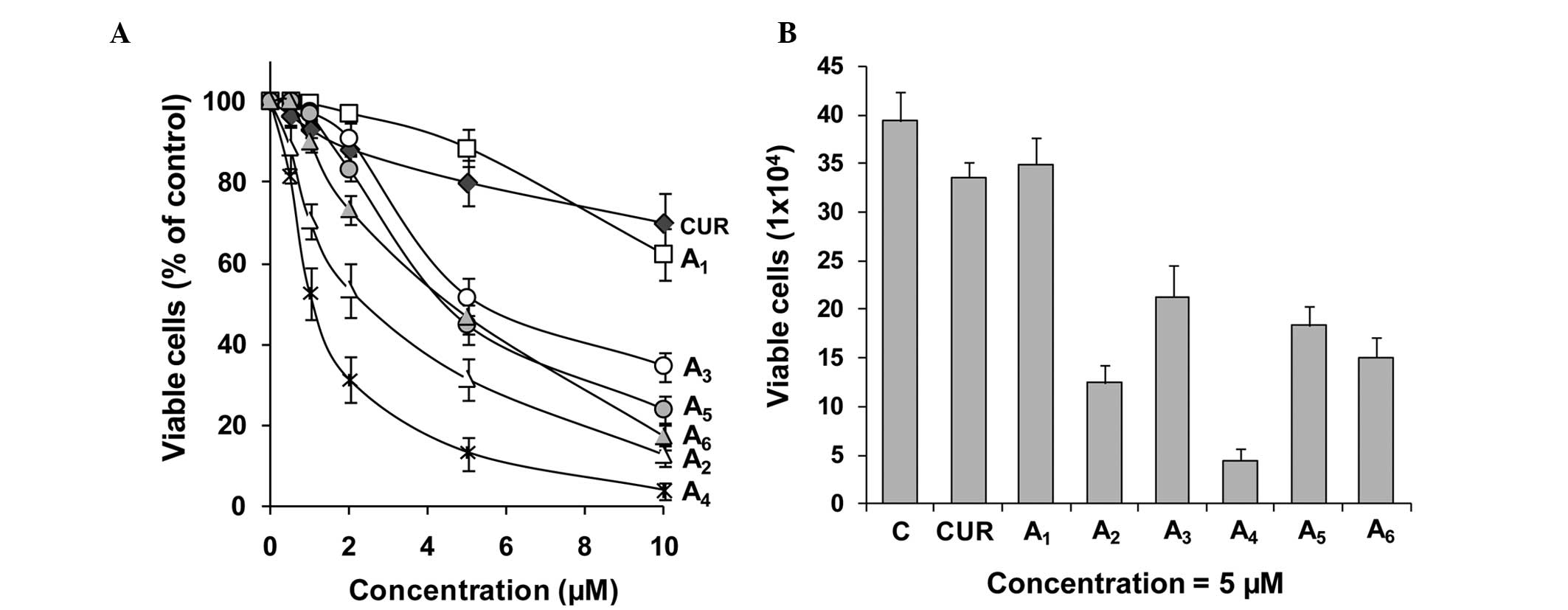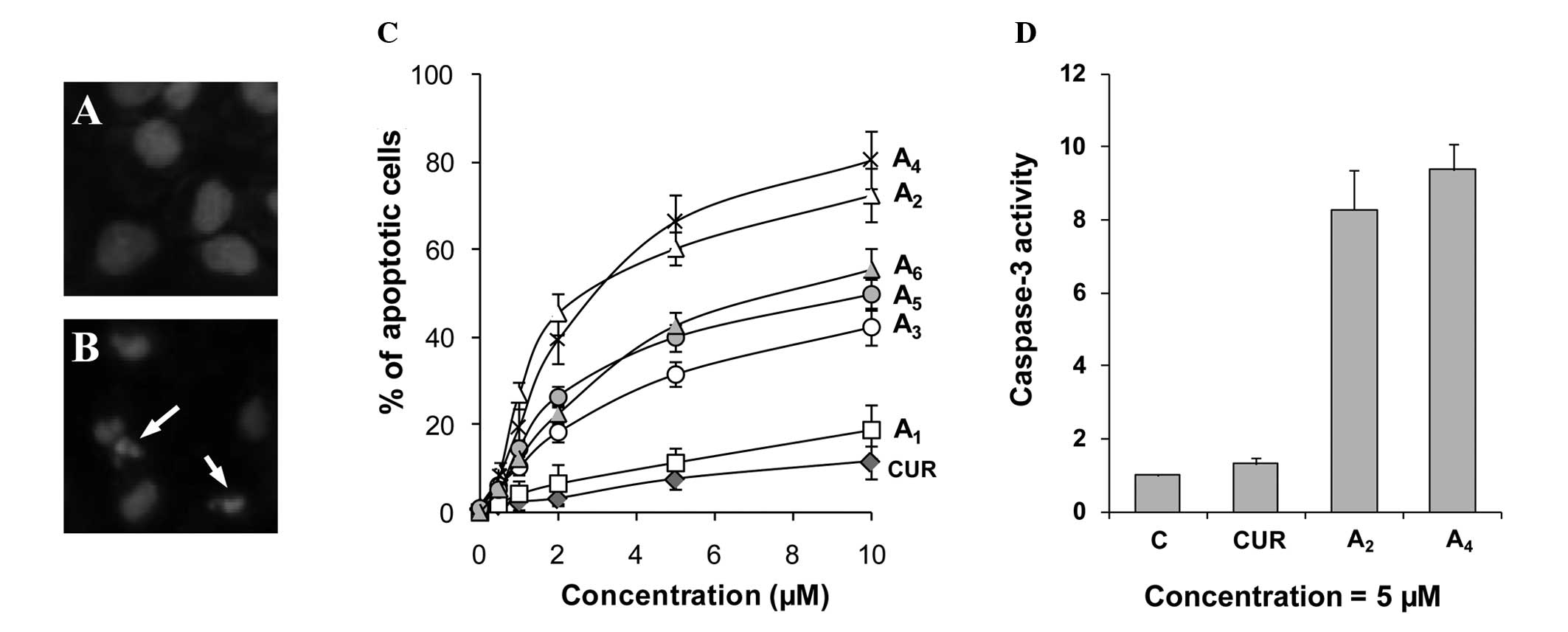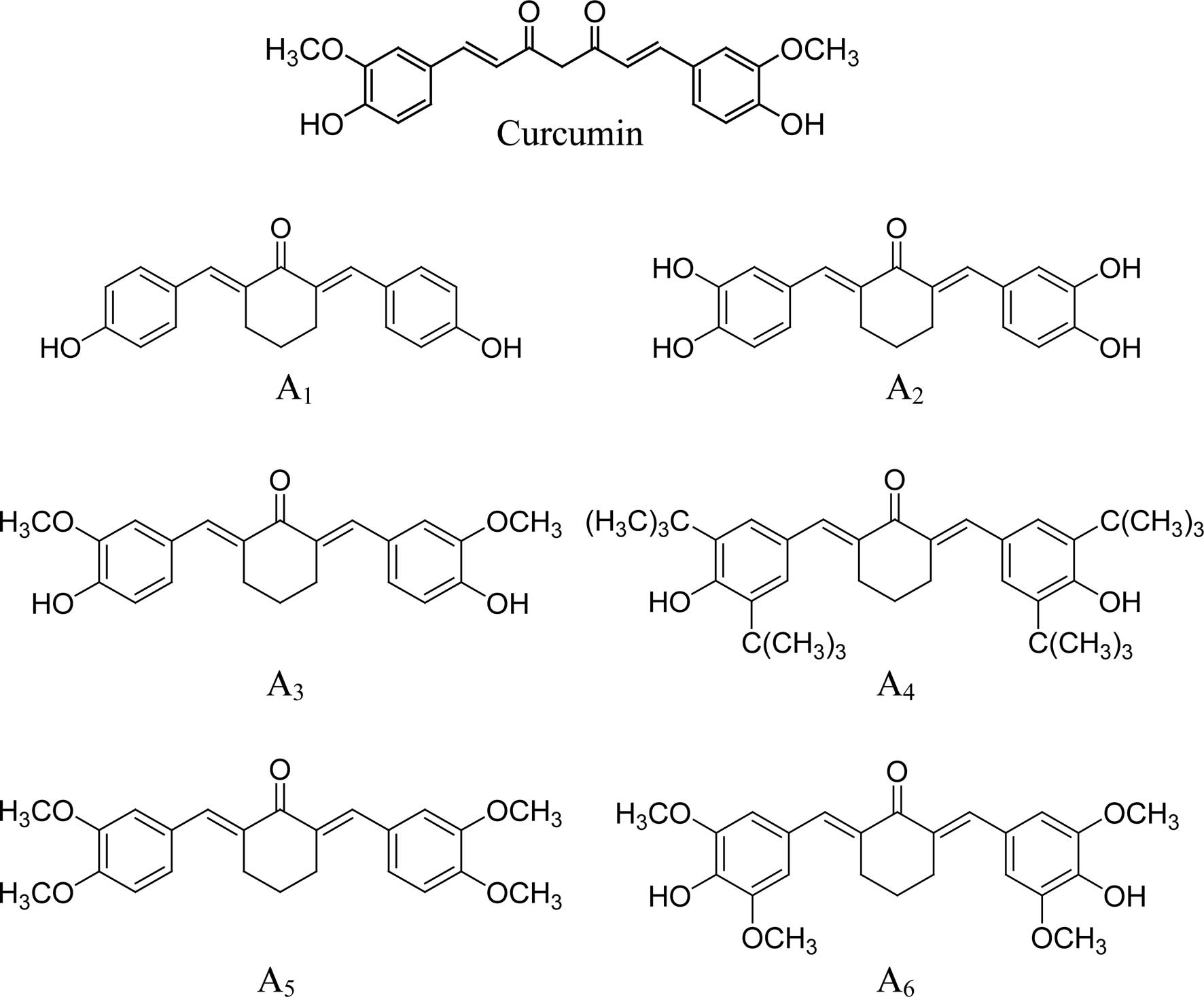|
1
|
Lao CD: Dose escalation of a curcuminoid
formulation. BMC Complement Altern Med. 6:102006. View Article : Google Scholar : PubMed/NCBI
|
|
2
|
Goel A, Kunnumakkara AB and Aggarwal BB:
Curcumin as ‘Curecumin’: from kitchen to clinic. Biochem Pharmacol.
75:787–809. 2008.
|
|
3
|
Aggarwal BB and Sung B: Pharmacological
basis for the role of curcumin in chronic diseases: an age-old
spice with modern targets. Trends Pharmacol Sci. 30:85–94. 2009.
View Article : Google Scholar : PubMed/NCBI
|
|
4
|
Moragoda L, Jaszewski R and Majumdar AP:
Curcumin induced modulation of cell cycle and apoptosis in gastric
and colon cancer cells. Anticancer Res. 21:873–878. 2001.PubMed/NCBI
|
|
5
|
Anto RJ, Mukhopadhyay A, Denning K and
Aggarwal BB: Curcumin (diferuloylmethane) induces apoptosis through
activation of caspase-8, BID cleavage and cytochrome c release: its
suppression by ectopic expression of Bcl-2 and Bcl-xl.
Carcinogenesis. 23:143–150. 2002. View Article : Google Scholar
|
|
6
|
Squires MS, Hudson EA, Howells L, Sale S,
Houghton CE, Jones JL, Fox LH, Dickens M, Prigent SA and Manson MM:
Relevance of mitogen activated protein kinase (MAPK) and
phosphotidylinositol–3-kinase/protein kinase B (PI3K/PKB) pathways
to induction of apoptosis by curcumin in breast cells. Biochem
Pharmacol. 65:361–376. 2003.PubMed/NCBI
|
|
7
|
Hanif R, Qiao L, Shiff SJ and Rigas B:
Curcumin, a natural plant phenolic food additive, inhibits cell
proliferation and induces cell cycle changes in colon
adenocarcinoma cell lines by a prostaglandin-independent pathway. J
Lab Clin Med. 130:576–584. 1997. View Article : Google Scholar
|
|
8
|
Mukhopadhyay A, Bueso-Ramos C, Chatterjee
D, Pantazis P and Aggarwal BB: Curcumin downregulates cell survival
mechanisms in human prostate cancer cell lines. Oncogene.
20:7597–7609. 2001. View Article : Google Scholar : PubMed/NCBI
|
|
9
|
Piantino CB, Salvadori FA, Ayres PP, Kato
RB, Srougi V, Leite KR and Srougi M: An evaluation of the
anti-neoplastic activity of curcumin in prostate cancer cell lines.
Int Braz J Urol. 35:354–360. 2009. View Article : Google Scholar : PubMed/NCBI
|
|
10
|
Hilchie AL, Furlong SJ, Sutton K,
Richardson A, Robichaud MR, Giacomantonio CA, Ridgway ND and Hoskin
DW: Curcumin-induced apoptosis in PC3 prostate carcinoma cells is
caspase-independent and involves cellular ceramide accumulation and
damage to mitochondria. Nutr Cancer. 62:379–389. 2010. View Article : Google Scholar
|
|
11
|
Teiten MH, Gaascht F, Eifes S, Dicato M
and Diederich M: Chemopreventive potential of curcumin in prostate
cancer. Genes Nutr. 5:61–74. 2010. View Article : Google Scholar : PubMed/NCBI
|
|
12
|
Cabrespine-Faugeras A, Bayet-Robert M, Bay
JO, Chollet P and Barthomeuf C: Possible benefits of curcumin
regimen in combination with taxane chemotherapy for
hormone-refractory prostate cancer treatment. Nutr Cancer.
62:148–153. 2010. View Article : Google Scholar : PubMed/NCBI
|
|
13
|
Ide H, Tokiwa S, Sakamaki K, Nishio K,
Isotani S, Muto S, Hama T, Masuda H and Horie S: Combined
inhibitory effects of soy isoflavones and curcumin on the
production of prostate-specific antigen. Prostate. 70:1127–1133.
2010. View Article : Google Scholar : PubMed/NCBI
|
|
14
|
Khor TO, Keum YS, Lin W, Kim JH, Hu R,
Shen G, Xu C, Gopalakrishnan A, Reddy B, Zheng X, Conney AH and
Kong AN: Combined inhibitory effects of curcumin and phenethyl
isothiocyanate on the growth of human PC-3 prostate xenografts in
immunodeficient mice. Cancer Res. 66:613–621. 2006. View Article : Google Scholar : PubMed/NCBI
|
|
15
|
Aggarwal BB and Shishodia S: Molecular
targets of dietary agents for prevention and therapy of cancer.
Biochem Pharmacol. 71:1397–1421. 2006. View Article : Google Scholar : PubMed/NCBI
|
|
16
|
Lin YG, Kunnumakkara AB, Nair A, Merritt
WM, Han LY, Armaiz-Pena GN, Kamat AA, Spannuth WA, Gershenson DM,
Lutgendorf SK, Aggarwal BB and Sood AK: Curcumin inhibits tumor
growth and angiogenesis in ovarian carcinoma by targeting the
nuclear factor-kappaB pathway. Clin Cancer Res. 13:3423–3430. 2007.
View Article : Google Scholar : PubMed/NCBI
|
|
17
|
Kunnumakkara AB, Guha S, Krishnan S,
Diagaradjane P, Gelovani J and Aggarwal BB: Curcumin potentiates
antitumor activity of gemcitabine in an orthotopic model of
pancreatic cancer through suppression of proliferation,
angiogenesis, and inhibition of nuclear factor-kappaB-regulated
gene products. Cancer Res. 67:3853–3861. 2007. View Article : Google Scholar
|
|
18
|
Sun ZJ, Chen G, Zhang W, Hu X, Liu Y, Zhou
Q, Zhu LX and Zhao YF: Curcumin dually inhibits both mammalian
target of rapamycin and nuclear factor-κB pathways through a
crossed phosphatidylinositol 3-kinase/Akt/IκB kinase complex
signaling axis in adenoid cystic carcinoma. Mol Pharmacol.
79:106–118. 2011.PubMed/NCBI
|
|
19
|
Jutooru I, Chadalapaka G, Lei P and Safe
S: Inhibition of NFkappaB and pancreatic cancer cell and tumor
growth by curcumin is dependent on specificity protein
down-regulation. J Biol Chem. 285:25332–25344. 2010. View Article : Google Scholar : PubMed/NCBI
|
|
20
|
Guo H, Yu JH, Chen K and Ye ZQ: Curcumin
induced the expression of inhibitor kappaBalpha protein in human
prostate cancer cells. Zhonghua Wai Ke Za Zhi. 44:1256–1259.
2006.PubMed/NCBI
|
|
21
|
Anand P, Sundaram C, Jhurani S,
Kunnumakkara AB and Aggarwal BB: Curcumin and cancer: an ‘old-age’
disease with an ‘age-old’ solution. Cancer Lett. 267:133–164.
2008.
|
|
22
|
Dhillon N, Aggarwal BB, Newman RA, Wolff
RA, Kunnumakkara AB, Abbruzzese JL, Ng CS, Badmaev V and Kurzrock
R: Phase II trial of curcumin in patients with advanced pancreatic
cancer. Clin Cancer Res. 14:4491–4499. 2008. View Article : Google Scholar : PubMed/NCBI
|
|
23
|
Cheng AL, Hsu CH, Lin JK, Hsu MM, Ho YF,
Shen TS, Ko JY, Lin JT, Lin BR, Ming-Shiang W, Yu HS, et al: Phase
I clinical trial of curcumin, a chemopreventive agent, in patients
with high-risk or pre-malignant lesions. Anticancer Res.
21:2895–2900. 2001.PubMed/NCBI
|
|
24
|
Wang YJ, Pan MH, Cheng AL, Lin LI, Ho YS,
Hsieh CY and Lin JK: Stability of curcumin in buffer solutions and
characterization of its degradation products. J Pharm Biomed Anal.
15:1867–1876. 1997. View Article : Google Scholar : PubMed/NCBI
|
|
25
|
Tomren MA, Másson M, Loftsson T and
Tønnesen HH: Studies on curcumin and curcuminoids XXXI. Symmetric
and asymmetric curcuminoids: stability, activity and complexation
with cyclodextrin. Int J Pharm. 338:27–34. 2007.PubMed/NCBI
|
|
26
|
Grogan G: Emergent mechanistic diversity
of enzyme-catalysed beta-diketone cleavage. Biochem J. 388:721–730.
2005. View Article : Google Scholar : PubMed/NCBI
|
|
27
|
Liang G, Shao L, Wang Y, Zhao C, Chu Y,
Xiao J, Zhao Y, Li X and Yang S: Exploration and synthesis of
curcumin analogues with improved structural stability both in vitro
and in vivo as cytotoxic agents. Bioorg Med Chem. 17:2623–2631.
2009. View Article : Google Scholar : PubMed/NCBI
|
|
28
|
Somers-Edgar TJ, Taurin S, Larsen L,
Chandramouli A, Nelson MA and Rosengren RJ: Mechanisms for the
activity of heterocyclic cyclohexanone curcumin derivatives in
estrogen receptor negative human breast cancer cell lines. Invest
New Drugs. 29:87–97. 2011. View Article : Google Scholar
|
|
29
|
Yadav B, Taurin S, Rosengren RJ,
Schumacher M, Diederich M, Somers-Edgar TJ and Larsen L: Synthesis
and cytotoxic potential of heterocyclic cyclohexanone analogues of
curcumin. Bioorg Med Chem. 18:6701–6707. 2010. View Article : Google Scholar : PubMed/NCBI
|
|
30
|
Du ZY, Bao YD, Liu Z, Qiao W, Ma L, Huang
ZS, Gu LQ and Chan AS: Curcumin analogs as potent aldose reductase
inhibitors. Arch Pharm (Weinheim). 339:123–128. 2006. View Article : Google Scholar : PubMed/NCBI
|
|
31
|
Zheng X, Cui XX, Avila GE, Huang MT, Liu
Y, Patel J, Kong AN, Paulino R, Shih WJ, Lin Y, Rabson AB, Reddy BS
and Conney AH: Atorvastatin and celecoxib inhibit prostate PC-3
tumors in immunodeficient mice. Clin Cancer Res. 13:5480–5487.
2007. View Article : Google Scholar : PubMed/NCBI
|
|
32
|
Ploszaj T, Motyl T, Orzechowski A,
Zimowska W, Wareski P, Skierski J and Zwierzchowski L:
Antiapoptotic action of prolactin is associated with up-regulation
of Bcl-2 and down-regulation of Bax in HC11 mouse mammary
epithelial cells. Apoptosis. 3:295–304. 1998. View Article : Google Scholar : PubMed/NCBI
|
|
33
|
Zheng X, Chang RL, Cui XX, Avila GE, Lee
S, Lu YP, Lou YR, Shih WJ, Lin Y, Reuhl K, Newmark H, Rabson A and
Conney AH: Inhibitory effect of12-O-tetradecanoylphorbol-13-acetate
alone or in combination with all-trans-retinoic acid on the growth
of LNCaP prostate tumors in immunodeficient mice. Cancer Res.
64:1811–1820. 2004. View Article : Google Scholar : PubMed/NCBI
|
|
34
|
Romero-Weaver AL, Wang HW, Steen HC,
Scarzello AJ, Hall VL, Sheikh F, Donnelly RP and Gamero AM:
Resistance to IFN-alpha-induced apoptosis is linked to a loss of
STAT2. Mol Cancer Res. 8:80–92. 2010. View Article : Google Scholar : PubMed/NCBI
|
|
35
|
Zheng X, Chang RL, Cui XX, Avila G, Huang
MT, Liu Y, Kong AN, Rabson AB and Conney AH: Inhibition of NF-κB by
(E)3-[(4-methylphenyl)-sulfonyl]-2-propenenitrile
(BAY11-7082; BAY) is associated with enhanced
12-O-tetradecanoylphorbol-13-acetate-induced growth
suppression and apoptosis in human prostate cancer PC-3 cells. Int
J Oncol. 32:257–264. 2008.
|
|
36
|
Chen A and Zheng S: Curcumin inhibits
connective tissue growth factor gene expression in activated
hepatic stellate cells in vitro by blocking NF-κB and ERK
signalling. Br J Pharmacol. 153:557–567. 2008.PubMed/NCBI
|
|
37
|
Li L, Aggarwal BB, Shishodia S, Abbruzzese
J and Kurzrock R: Nuclear factor-κB and IκB kinase are
constitutively active in human pancreatic cells, and their
down-regulation by curcumin (diferuloylmethane) is associated with
the suppression of proliferation and the induction of apoptosis.
Cancer. 101:2351–2362. 2004.
|
|
38
|
Aggarwal BB: Nuclear factor-κB: the enemy
within. Cancer Cell. 6:203–208. 2004.
|
|
39
|
Arlt A, Gehrz A, Müerköster S, Vorndamm J,
Kruse ML, Fölsch UR and Schäfer H: Role of NF-kappaB and Akt/PI3K
in the resistance of pancreatic carcinoma cell lines against
gemcitabine-induced cell death. Oncogene. 22:3243–3251. 2003.
View Article : Google Scholar : PubMed/NCBI
|
|
40
|
Holley AK, Xu Y, St Clair DK and St Clair
WH: RelB regulates manganese superoxide dismutase gene and
resistance to ionizing radiation of prostate cancer cells. Ann NY
Acad Sci. 1201:129–136. 2010. View Article : Google Scholar : PubMed/NCBI
|
|
41
|
Karin M: NF-κB as a critical link between
inflammation and cancer. Cold Spring Harb Perspect Biol.
1:a0001412009.
|
|
42
|
Royuela M, Rodríguez-Berriguete G, Fraile
B and Paniagua R: TNF-α/IL-1/NF-κB transduction pathway in human
cancer prostate. Histol Histopathol. 23:1279–1290. 2008.
|
|
43
|
Paule B, Terry S, Kheuang L, Soyeux P,
Vacherot F and de la Taille A: The NF-κB/IL-6 pathway in metastatic
androgen-independent prostate cancer: new therapeutic approaches?
World J Urol. 25:477–489. 2007.
|
|
44
|
Flynn V Jr, Ramanitharan A, Moparty K,
Davis R, Sikka S, Agrawal KC and Abdel-Mageed AB:
Adenovirus-mediated inhibition of NF-κB confers chemo-sensitization
and apoptosis in prostate cancer cells. Int J Oncol. 23:317–323.
2003.
|
|
45
|
Wang D, Veena MS, Stevenson K, Tang C, Ho
B, Suh JD, Duarte VM, Faull KF, Mehta K, Srivatsan ES and Wang MB:
Liposome-encapsulated curcumin suppresses growth of head and neck
squamous cell carcinoma in vitro and in xenografts through the
inhibition of nuclear factor κB by an AKT-independent pathway. Clin
Cancer Res. 14:6228–6236. 2008.PubMed/NCBI
|
|
46
|
Kasinski AL, Du Y, Thomas SL, Zhao J, Sun
SY, Khuri FR, Wang CY, Shoji M, Sun A, Snyder JP, Liotta D and Fu
H: Inhibition of IkappaB kinase-nuclear factor-kappaB signaling
pathway by 3,5-bis(2-flurobenzylidene)piperidin-4-one (EF24), a
novel monoketone analog of curcumin. Mol Pharmacol. 74:654–661.
2008. View Article : Google Scholar : PubMed/NCBI
|













